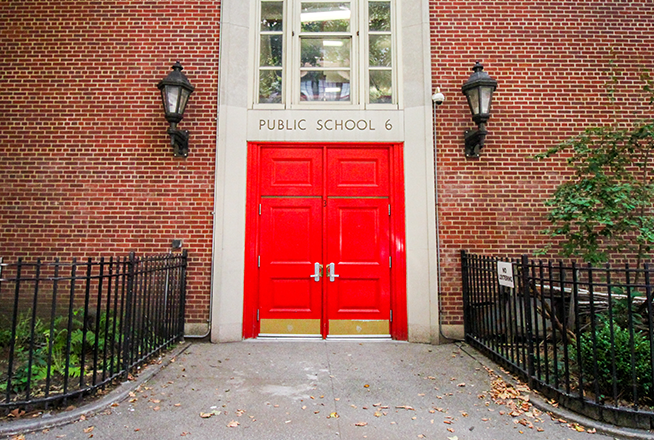A Progressive Vision for Educational Choice: 5 Questions to Ask
Aldeman: Voters like school choice. By demonizing it, the left is missing out on opportunities to shape the debate over the future of public education

Get stories like this delivered straight to your inbox. Sign up for The 74 Newsletter
I like public schools. I attended them. My kids attend them. As I write this, I’m drinking coffee out of a mug quoting Mark Twain saying, “Out of public schools grows the greatness of a nation.”
But I’ve grown increasingly uncomfortable with warnings coming out of the political left that educational choice programs will “destroy public schools” or “harm our society,” and that calls for more educational choices represent an “assault on American democracy.”
These arguments are wrong on the merits, and they’re leading progressives to miss out on opportunities to shape the debate over the future of American public education.
First, this system, as currently structured, is not exactly a model of excellence or equity. There’s room for improvement.
Second, it’s hard to argue that geography-based school assignment is the key to democracy. “Public” schools excluded women and racial minorities for much of U.S. history, and many other countries have much more active democratic participation than we do.
Third, other democratic countries have much broader and more “pluralistic” definitions for public education than we do here in the U.S. Millions of kids in Canada, Australia and much of Europe attend schools that are publicly funded but are not run by anything like America’s local school districts. “Public education” doesn’t have to mean “traditional school districts.”
Instead of painting the movement to provide more educational choices for families as a right-wing bogeyman, progressives would be better off understanding that voters, especially Black and Latino parents, support greater options within the public schools.
What should those options look like? State advocates will surely have their own priority list, but here are five questions progressives should ask as they evaluate K-12 educational choice proposals:
Are programs allowed to discriminate?
The current public education system is not great at promoting integration, and school choice programs will inevitably allow people to self-segregate into like-minded communities. States should protect against bad actors by requiring that any school accepting public money be prohibited from discriminating based on a student’s national origin, race, color, religion, disability, gender or familial status. If public money is going to private educational programs, they must be open and accepting of all students, and there must be protections and avenues for students and families to resolve conflicts. This should be a minimum bar to accepting public money.
Is there a real check on quality?
Progressives worry that private programs won’t teach kids content aligned to state standards (especially around science or social studies), or that for-profit providers could step in and reap profits while providing a low-quality education. There’s a clear solution: Require every participating student to take the same state tests as kids in traditional public schools. States can then give parents direct feedback about how their child is doing and use the results to shut down low-performing programs.
According to EdChoice, recently passed education savings account programs in Iowa, Indiana and Arkansas all require that recipients take state and federal tests. Arizona and Utah do not. West Virginia’s program has a testing element in name only: Private schools have to test kids, but they can choose from a list of approved assessments. That’s not good enough. Anyone who cares about program quality should insist that all kids be tested against the same statewide standards.
Are the funding amounts progressive?
Many progressives worry that choice programs are really handouts to wealthy families who don’t like paying taxes or supporting public schools. That fear is well-founded, based on how some programs were designed in the past. For example, a recent analysis from the Institute on Taxation and Economic Policy found that households claiming voucher tax credits in Arizona, Virginia and Louisiana were especially skewed to high-income families.
The more recent educational savings account bills provide the same amount to all eligible students. Many of the programs also limit eligibility based on family income or tied to specific student populations (like kids with disabilities).
States could go one step further to make the funding amounts progressive as well. After all, one lesson from school finance research is that it costs more to teach higher-need students. If states want to set up a truly robust educational choice market — and give disadvantaged students an equal footing — they should award higher dollar amounts to low-income students, English learners and children with disabilities.
Is the program actively supporting disadvantaged families?
Transparency and accountability can go a long way to helping families make good choices (see No. 2 above). But complexities in program design and administration processes also favor the wealthy; high-income families have a much easier time than lower-income parents navigating complicated programs, and they’re more likely to pay someone to help. If states want to provide educational options available to all families, they should consider funding choice navigators, who can act as independent counselors, help students understand their learning needs, assist parents in advocating for their children and smooth the choice process.
Does the state treat existing providers (traditional school districts) fairly?
Many progressives are justifiably concerned about what happens to traditional districts if they lose students, especially the most active and engaged families. They could become the school of last resort for the most expensive, most disruptive kids. These fears are somewhat overblown. Competition actually seems to improve traditional school districts, and local district revenues have not been as affected as you might assume in places where charter schools have gained market share. That’s mainly because the district might lose out on state funds when kids transfer out, but they still receive the same amount of local funds to educate fewer students.
Still, states should not merely layer an educational choice program on top of their existing funding structure. Over time, that will put a bigger burden on districts that made staffing commitments, built school infrastructure and promised employees future benefits based on enrollment projections that are no longer accurate. As one example, teacher pension debt obligations should be considered the state’s responsibility rather than passed on to individual districts.
State leaders would need to look carefully at how to treat school districts fairly, and their options will depend on how the state budgets for things like transportation, facilities and employee retirement benefits. They could also provide short-term adjustment funding for districts that lose market share to other types of schools, as some do for charters.
It’s past time that state leaders grappled with questions about how to ensure all kids have access to a high-quality education, without assuming that local school districts, as currently conceived, are the only way to accomplish that mission. The COVID-19 pandemic showed, once again, that the American system of geographically based school districts is not as nimble or flexible as it could be.
Some people on the left reflexively defend local school districts and oppose any form of public education that looks different. But progressives need to engage in these debates to fight for policies that help the kids who depend on public education the most.
Get stories like these delivered straight to your inbox. Sign up for The 74 Newsletter

;)
